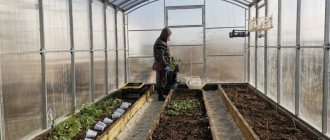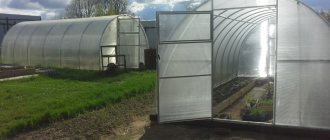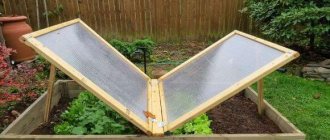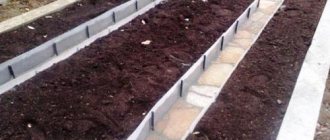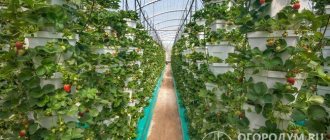Review author: Terrari School of Design
Creating a lush rose garden in your country house with your own hands is not as simple as it seems. Especially if the area of residence is in the middle or northern latitudes. But if you choose the varieties of roses, choose the right place, think through the planting scheme, apply diligence and hard work, then you can quite get a good result.
Taking into account the advice given in the article, it will be much easier to cope with the work.
Design style
First of all, you need to decide how to design the flower garden. It will be strictly rectangular, oval, or this shape will be free, not necessarily correct.
It's worth thinking about edging. One way to decorate it is with brick and marble chips, crushed stone and pebbles, or simply a low fence.
Even if you don’t adhere to geometric shapes, there should be order in the flowerbed, even if it’s creative.
Advantages and disadvantages
If you still doubt whether you should use roses in your garden, let’s consider all the associated advantages and disadvantages of this choice.
Advantages
- Beauty. This is the first and most powerful argument. Whatever one may say, a rose is a flower of extraordinary beauty.
- A large assortment. At the moment there are many fans of this culture. And the breeders took care of them, providing a large selection of different species.
- Care. Roses do not require special feeding or very complex care.
Flaws. We figured out the only drawback: poor frost resistance. Roses are heat-loving plants, so the harsh Russian frosts are not to their liking. However, frost-resistant species already exist. In addition, a grafted rose is more resistant to frost. So this issue can be easily resolved.
The only drawback of roses is poor frost resistance
Roses will look very beautiful in your yard design
See alsoCreating a flower garden is one of the forms of creative self-expression
Location determination
For roses, it is important to choose a site where there is sun all day, the soil is fertile and there are no drafts. Places with strong humidity and shaded areas are not suitable for creating a beautiful rose garden.
If the groundwater comes close to the surface, then it is better to raise the flowerbed by 30-50 cm. Otherwise, the plants will grow weak and you won’t be able to see lush flowering. The ideal planting area would be a southern slope if the area is hilly.
Selecting and preparing a place for a flower bed
The first step to creating a beautiful rose bed is choosing the right place and providing comfortable conditions for the proud beauty.
Rose is a sun-loving plant, but the scorching midday heat does not do it any favors. Therefore, the ideal place for planting a rose garden would be a place illuminated by the sun in the morning and evening, and from about 12 to 15 hours there should be partial shade. In addition, it must be protected from strong winds and drafts. What can you do, queen...
The rose is not particularly demanding on soil; light, nutritious loams or black soil are preferred. Acidity is close to neutral.
An important point when planting roses is soil moisture. They do not tolerate close proximity to groundwater and excess moisture. Therefore, before planting, it is recommended to provide them with good drainage (crushed stone, gravel, expanded clay, coarse sand).
It is necessary to leave enough space between the bushes to allow for growth, because thick planting increases the risk of black spotting on roses and other problems.
After choosing a location, you should not be lazy and, armed with pencils, draw a rough diagram of the desired flower garden. This will allow you to avoid some mistakes later. You should not create complex intricate patterns in the rose garden, or get carried away with a large number of companion flowers. A rose is beautiful in itself; like a work of art, it only needs an unobtrusive frame.
Creating a rosary composition
To design a rose garden at your dacha, you need to think through the following nuances: color, drawing of the location of all plants, choose varieties of roses and think about what style it will be in. Only roses may bloom here, or there will also be plants to complement and create the landscape.
Color
The selection of colors speaks volumes about the taste of the owners, so it is better to approach this consciously. A combination of white and cream shades of roses, diluted with lilac tones of shrubs, will be harmonious.
You can take all shades of red flowers (from soft pink to burgundy) or yellow, complementing them with perennial evergreens (ferns, hostas, conifers, junipers). They will help preserve the beauty of the arrangement when the flowers fall.
Arrangement of roses in a flower garden
Before planting flowers, be sure to draw a diagram of the rose garden so that you know where to plant which bush.
In the first tier you need to place low-growing varieties: Patio, ground-blooded, miniature. Non-prickly ones are better.
The second tier is suitable for Floribunda, hybrid tea roses. Background, third - for park, standard, climbing varieties and bushes of other plants.
Selection of rose varieties
When buying rose seedlings, they usually look at the color and size of the flower, but do not pay any attention to disease resistance or frost resistance. But this is an important parameter. Taking care of sheltering your pets can take a lot of time and effort. But there are varieties that, with minimal care, will delight you with their flowering all summer long.
So buying at the market or from random sellers may not be successful. You need to purchase seedlings in specialized stores and from reliable suppliers, studying the characteristics in detail so as not to be disappointed.
What flowers go with roses?
To make the rose garden beautiful from spring to autumn, flowers that do not have strongly branching roots are planted in it.
In the early season, you can grow crocuses, muscaria, daffodils, tulips, and primroses here. In summer, garden geraniums, irises, gladioli, asters, carnations, sedum, and alyssum bloom. Boxwood, hostas, ferns, and juniper will decorate at any time of the year.
When planting these plants, care is kept to a minimum. They are less susceptible to disease and freezing in winter; rose fertilizers are also suitable for them. They also serve as a good background.
Where to place a flower bed with roses on the site
There are a large number of types of roses that can be planted in your summer cottage. They differ not only in the aroma and appearance of the flowers, but in the height of the stems, the ability to bush, and the density of the buds.
Some species need support, others do well without it. In addition, it is necessary to take into account the ability of different species to tolerate heat and frost, resistance to diseases and pests.
The design of the flower bed depends on the selected species.
A flowerbed is understood as an area of soil, artificially bounded on all sides, having a certain shape and size. As a rule, the flowerbed is slightly raised above the ground to focus attention on it.
To make flower beds with roses look aesthetically pleasing, you need to take care of selecting plants that will settle nearby. Flowering dates can coincide or replace each other, the main thing is that the selected plants do not harm each other.
When choosing a place for roses on your site, you need to take into account that southern beauties need sunlight and warmth, so the rose garden is laid out in an open, sunny area.
It is preferable to provide protection from wind and drafts, for example, plant roses near the house (just not close to the wall) or along the fence so that the rose garden is not in the shade.
If we are not talking about a flower bed, but about a flower garden, then low pink bushes that frame the paths in the garden area look good.
It is important that the thorns do not interfere with free movement in the countryside, so in this case it is better to choose upright varieties that will not grow much.
Planting roses
About the distance between bushes
It is important to maintain a certain distance when planting cuttings, because as the branches grow they thicken the space. This contributes to air stagnation, diseases occur, flowering and plant nutrition are disrupted.
The distance between low-growing cuttings should be 40 cm, hybrid tea and floribunda half a meter is enough, park varieties need to be planted a meter apart, climbing varieties require more sparse planting - from 1.5 meters to 3.
Deepening the graft on a rose
If there is a graft, it is better to bury it 5 cm into the soil. In this case, the root shoots will not develop and will have to be removed to a lesser extent.
Top dressing
Feeding roses with nitrogen and organic fertilizers is needed in spring and early summer. This gives growth and development of green mass. Overfeeding leads to fattening and the appearance of aphids on the plant.
During the budding period, you should feed the bush with potassium, phosphorus, and magnesium to ensure abundant flowering. After trimming faded buds, complex fertilizers should be applied to re-bloom. At the end of summer, it is good to add organic matter and wood ash, which will prepare the plant for winter.
It is better to apply mineral fertilizers in dry form. First you need to water the plant, add a small amount of fertilizer and water the bush again.
Under no circumstances should nitrogen be applied at the end of summer, as this will lead to the growth of green mass. Such a rose can die, even if it is well covered for the winter.
Watering
It is better to exercise it rarely, but plentifully. Especially when feeding is done. This should be done in the morning or evening.
But how to design a rose garden at the dacha so that it fits in and complements the buildings on the site?
Selection of varieties and shades
We have already talked about shade-tolerant plants. But remember that the ideal option is a bright place where they will be exposed to sunlight for at least three hours a day. There are a huge number of varieties, among which several groups suitable for flower beds can be distinguished: bush, standard, ground cover, hybrid tea.
Climbing varieties can theoretically be used, but they will require support for the branches to cling to. Gardeners recommend choosing several shrubs from each group or color for one bed so that it doesn't look tacky.
- Light flowers look beautiful against dark hedges and walls. Bright - on light. But there are no clear rules and it all depends on the specific situation and your preferences. The main thing is that the plantings do not blend into the background.
- In a small area or along paths, it is better to plant low-growing roses. Especially if the path is curved, small flowers will emphasize the curves.
- When designing a large object, you cannot do without varieties of different heights. The tallest ones are usually located in the center.
- Ground covers are suitable for small areas and slopes.
- Species with large inflorescences can be planted separately; with small ones you will not be able to get a harmonious picture.
Color combinations
A monochrome planting scheme works well with white and pale shades. They can be diluted with rich greens. If this option seems too boring, try using these rules.
- Related colors of exclusively warm or cold tones go well together.
- Red inflorescences are diluted with delicate cream, yellow and other pastel palettes.
- Lilac and blue shades are considered universal. They fit into both warm and cold-colored mixborders.
Designers advise choosing varieties that will bloom all summer or combining plants that bloom at different times.
6
photo
Dwarf rose and lavender
Hedge
For a rose garden along the fence of the site, climb varieties that bloom for a long time and do not require shelter for the winter.
In the first row, medium-sized ones should be planted, with stems up to one and a half meters high. The second row will be created by roses with long lashes, from 3 to 7 meters. It is better to plant in a checkerboard pattern.
Landing schemes
To plant plants, you should do the following:
- Clean the seedlings from the soil and soak them in water for 1 hour.
- Remove leaves and flowers and trim stems to 10-15 centimeters.
- Make a hole 60 centimeters deep.
- Immerse the plant in it.
- Compact the soil, water and sprinkle with sawdust or peat.
Between small varieties of roses it is worth maintaining a distance of at least 25 centimeters. If the plants are large, maintain a distance of at least 50 centimeters.
A distance of 2 meters is required between tall crops.
Vertical gardening
Decorating gazebos, terraces, arches, and facades in a vertical plane is an excellent solution not only aesthetically, but also protection from dust, noise, wind and summer heat. Climbing roses with medium and small flowers are suitable for this.
In combination with clematis and virgin grapes, they will create unique beauty and give an unforgettable experience.
Additional flower bed design options
When decorating a flower bed, you can use a variety of plants. This helps flower growers choose the best options.
Ornamental shrubs
It is permissible to decorate a flowerbed with bushes. They are placed in the central part or used as a border.
Conifers
Roses are combined with conifers. Compact spruces, thujas, and junipers are suitable for this.
Herbs and grains
This combination looks casual and at the same time natural. It is worth choosing ostrich, hostas, and low spikelets.
Other perennials
It is best to choose low plants that are placed at a certain distance from the main crops.
Flowerbed
The classic version of a medium or large flower garden should be planted with standard roses. They are in harmony with hybrid tea varieties and floribunda. The edges will be decorated with dwarf or ground-blooded animals that are capable of creeping. Be sure to place it on a hill. The larger the flowerbed, the higher it is.
If we take into account all the above points, then the question of how to make a rosary will disappear. And even novice flower growers will cope with this task perfectly and get real pleasure.
Small flower garden or large
A flowerbed is only part of a flower garden. Therefore, when planning to plant flowers, you need to decide what should happen in the end. This could be a modest flowerbed in which several small rose bushes will grow. Perhaps in proximity to other plants that are not dangerous to roses.
Or it will be a flower garden of various types of roses, complemented by other plants. The golden mean is quite possible, but the planning begins with the design of the planting scheme.
If space allows and there is a desire to plant different varieties of roses on the site, then you need to think through a plan so that tall bushes do not shade or hide short-growing neighbors.
And climbing plants must receive the support they need. If we are talking about flower beds, then you should pay attention to varieties that are suitable specifically for this purpose.
In large flower beds you can combine roses. For example, tall bushes are in the center, and as you approach the edges, the growth of the bushes decreases.
In addition, you need to think about planting so that the roses bloom, replacing each other. This way the flowerbed will look elegant for a long time.
Among other things, we must not forget that in winter, rose bushes need to be covered to protect them from frost. Therefore, when planning a large flower garden, you need to think about this point in advance.
Photo of the rose garden
Care
The key to a beautiful and long-living corner with roses is proper care. Naturally, the plant requires watering. When performing this task, monitor the required water level: do not overfill, but do not let it dry out.
Feed the flowers. Roses do not require special nutrition. However, they will benefit from additional soil nutrients.
The key to a beautiful and long-lived corner with roses is proper care
It is recommended to insulate roses for the winter
Meet the required lighting conditions in accordance with the type of plant.
Cover roses for the winter, as they are not frost-resistant.
As you can see, the rose is the queen of flowers, and everyone can cope with it. The main thing is proper care and creating a composition with a heart filled with love for flowers.
Expert opinion
Alina Kvileva
Landscape designer
Hello, my name is Alina and I am a landscape designer, if you have any questions regarding landscape design, ask, I will be happy to answer them.
See alsoDesign ideas for decorating a terrace
